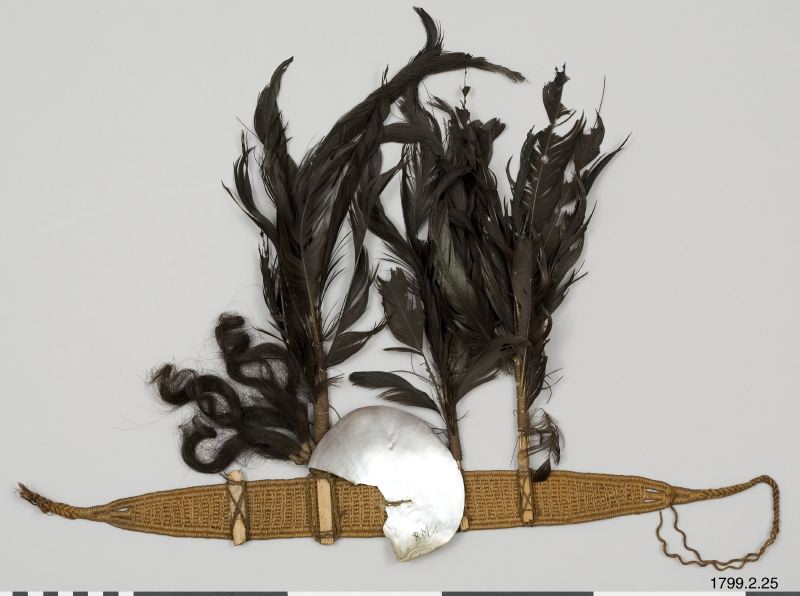| Typ <itemType> |
Objekt/föremål |
| Datering <presTimeLabel> |
1700 |
| Plats <presPlaceLabel> |
Oceanien, Franska Polynesien, Marquesasöarna, Tahuata |
| Beskrivning <itemDescription> |
-
"Huvudprydnad, flätad bindel af kokosfibrer, prydd med ett rundt musselskal och fjädrar." Generalkatalogens text.
Referens till "Man from the Marquesas" i "Atlas to Cook´s second voyage", London 1777 samt Marquesan artifact plate ur d:o. Kaeppler 1978 sid 10, samt fig 306, 307). "The uhikana .. belongs to the more simple type that lacks the open-work plates of tortoise-shell in front of the mothe...
Visa hela
"Huvudprydnad, flätad bindel af kokosfibrer, prydd med ett rundt musselskal och fjädrar." Generalkatalogens text.
Referens till "Man from the Marquesas" i "Atlas to Cook´s second voyage", London 1777 samt Marquesan artifact plate ur d:o. Kaeppler 1978 sid 10, samt fig 306, 307). "The uhikana .. belongs to the more simple type that lacks the open-work plates of tortoise-shell in front of the mother-of-pearl plate, the uhi...
It is perhaps only this type, fitted with tortoiseshell that has a valid claim to the appellation uhikana, seeing that kana, accordning to v. d. Steinen (vol II, p. 18) means "glistering" or "lustrous", epithets which in this connection would not refer to the mother-of-pearl, but to the ornately worked tortoise-shell. From Sparrman's account of his travels (II:2 p.61) it appears that he acquired both his uhikana specimenns in Tahuata ("Christina"), i.e. in the S.W. group. Sparrman (op.cit.), who refers to the uhikana as "a kind of diadem or bandeau royal", gives the following description of it: "the diadem consists of a flat piece of mother-of-pearl, partly overlaid with an artistically sculptured sheet of tortoise-shell. This ornament, together with one of more small pieces of pearl-oyster shell, and the plumes, contrast very pleasantly with the face and body, which are always heavily tattooed and thereby quite dark in colour". . .The plumes referred to by Sparrman were black cock feathers, attached to the back of the diadem. Söderström sid 22 ff.
Stäng
|
| Förvärvsomständigheter / i fält <itemDescription> |
|
| Anmärkning <itemDescription> |
|
| Källor <itemDescription> |
|
| Utställning / tidigare <itemDescription> |
|
| Referens, publicerad i <itemDescription> |
|
| Geografiskt namn / annat <itemDescription> |
|
| Geografiskt namn / annat <itemDescription> |
|
| Geografiskt namn / annat <itemDescription> |
|
| Geografiskt namn / annat <itemDescription> |
|
| Geografiskt namn / annat <itemDescription> |
|
| Geografiskt namn / annat <itemDescription> |
|
| Land / engelska <itemDescription> |
|
| Geografiskt namn / annat <itemDescription> |
|
| Geografiskt namn / annat <itemDescription> |
|
| Händelse / var närvarande vid <itemDescription> |
|
| Händelse / var närvarande vid <itemDescription> |
|
| Händelse / var närvarande vid <itemDescription> |
|
| Utställning, extern / tidigare <itemDescription> |
|
| Händelse <context> |
-
Insamlad av 1772-75.
-
Ursprung i Marquesasöarna, Franska Polynesien, Oceanien.
-
Tillverkad 1700 - .
-
Lånad 2008 - 2014-02 av Observatoriemuseet.
-
Utställd 2018-10-06 - 2019-03-03 i Etnografiska museet, Stockholm av Feathers.
|
| Material, engelska<itemMaterial> |
- plant fiber
- feather
|
| Materialkategori<itemMaterial> |
- animaliskt material
- växtmaterial
|
| Material<itemMaterial> |
- tuppfjäder
- människohår
- fjäder
- snäcka
- växtfiber
- tapa
|
| Teknik <itemTechnique> |
|
| Nyckelord <itemKeyWord> |
-
1799.02.0025
-
Dräkt (290)
-
Dräkt (291)
-
RM.389
-
kläder
-
klädesplagg
-
plagg
|
| Mått <itemMeasurement> |
-
Längd: 75 cm.
-
Längd: 40 cm.
-
Höjd: 37 cm.
|
| Lokalt namn<itemName> |
- uhikana
|
| Sakord, engelska<itemName> |
- head ornament
|
| Sakord<itemName> |
- huvudprydnad
- huvudbonad
- prydnad
|
| Ämne <subject> |
|
| Inventarienummer <itemNumber> |
|
| Tidigare identitet <itemNumber> |
|
| Rättigheter för metadata <itemLicense> |

|
| Källa <presOrganization> |
Statens museer för världskultur - Etnografiska museet |
|
Källa <url>
|
|








 ARTIKLAR I WIKIPEDIA
ARTIKLAR I WIKIPEDIA ARTIKLAR I WIKIDATA
ARTIKLAR I WIKIDATA BILDER I WIKIMEDIA COMMONS
BILDER I WIKIMEDIA COMMONS












